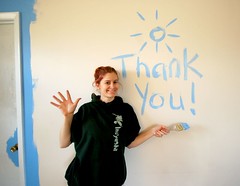
Next week we start Terra Nova testing. It's a week that throws everything up in the air. I never know who I'm going to teach, how long, or how many students will be in the class at the same time.
I heard a bit today that makes it sound like I'll have each class once and the classes that are usually split (K-2) will be in the room all at once. So, I needed a plan to keep everyone happily occupied while sharing computers.
I have had Google Earth open a few times in the past month. The students in second and seventh grade liked it. The second grade used it to find out where their email pals went to school. We just looked at the neighborhood and tried to see what we could see. We found a lot of empty space (it looked like large stretches of dirt) at one school. When they wrote we learned that they are in the middle of the biggest cotton patch in the world.
The seventh grade had a temporary classmate for one week. He was visiting his cousins over summer break from Argentina. His family thought going to our school for a week would be a great way to practice his English. He had a good command of the language as far as I could tell. Rather than having the standard class lesson that I had prepared for the day, I started up Google Earth. The student showed us around his town and then my students showed where the lived.
I have read that there are many uses for Google Earth in the class, so I decided to plunge into it next week since it's going to be an odd week anyway.
I put out a tweet: I have to explore Google Earth this week. Going to have room full of first graders next week and it might fit the bill during testing week. A short bit later, I received a link from @Digimom to her blog with resources for Google Earth from a TCEA workshop.
I was going to poke around delicious links, but this set was just what I needed. After poking around a short bit, I found what looks like the tip of a nice project iceberg.
There was a set of Google Earth Lesson Links and I chose Google Lit Trips. My plan was to find something for early elementary set - preferably first/ second/ third grade maybe. A cute story that I enjoyed reading to my boys was Make Way for Ducklings by Robert McClusky. There was a pre-made trip around Boston to all the stops the ducks made in the story. Perfection.
We can have a read aloud with the story and follow the trail in Google Earth. If I have time, we'll draw something in Kid Pix, or it can be carried into the class the following week.
These types of serendipitous events happen so often with my fine network. Thanks for helping me out Anna. Hopefully this blog post will be found by someone with a similar need. If you try something based on this post, let me know how you extended the lesson. I'm thinking along the lines of creating a story where the ducks come to our town. We have the Rahway River near the school and it would make an interesting digital story.



